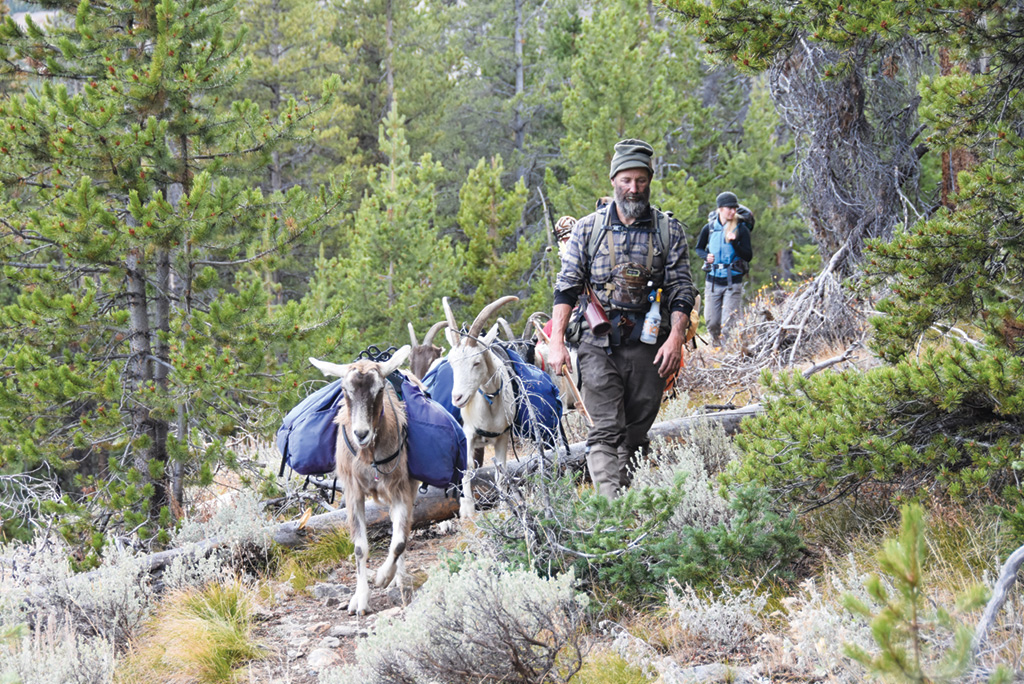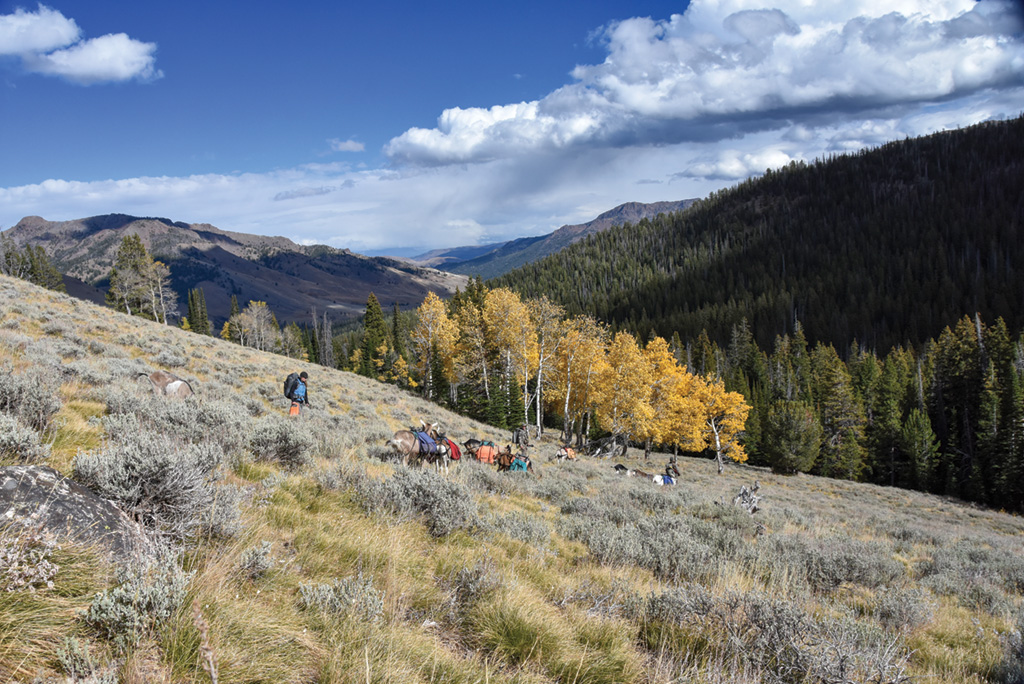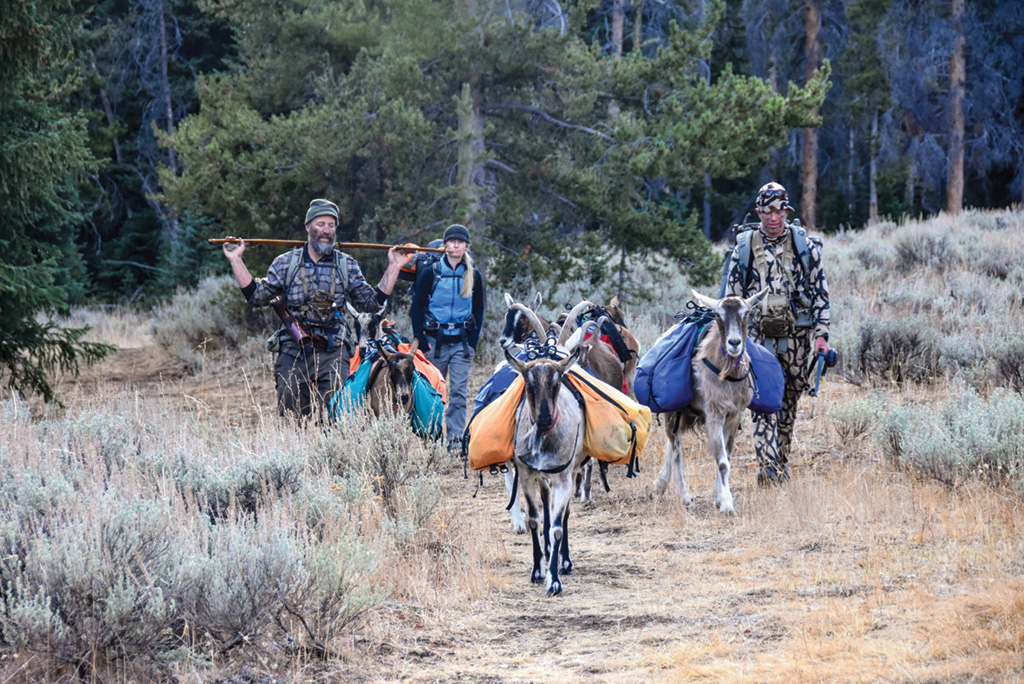When my brother Benji Hill first told me he was getting pack goats, my first words were, “Huh? Goats?” A response which, I now know, is shared by many when someone first suggests bringing goats along on a backcountry adventure.
Benji persevered. “Goats are easy to take care of, and they carry all your gear for you into the backcountry. Better yet, they don’t need any food out there. They eat grass and are like Labradors, just following you around.”
I was A-OK with the idea of someone else schlepping my gear for me on our summer backcountry trip into the Sawtooths and our fall elk hunts into the Pioneer Mountains. Truthfully, I was wondering if that meant I could add a little more weight in the packs for some hearty meals, a good sleeping pad, and perhaps a bottle of tequila for after the day’s hunt.
Benji had bought a small goat-packing outfit called Goat Pro Idaho out of Boise, and with it came the first three goats. Elvis, Sanuk and Beavis were a few of the early members of the crew gathered from others in the goat-packing community, a tight-knit group of folks that all are members of the North American Packgoat Association (napga.org).
Goat packing was popularized by biologist John Mionczynski in the 1980s in Wyoming’s Wind River Range. Studying Rocky Mountain bighorn sheep, Mionczynski had a good deal of equipment to carry into the high mountains. He tried horses and then mules to follow the sheep into the high wild terrain but found he couldn’t get near the area where the sheep lived. Undeterred, he trained his pet wether (a castrated male goat) to wear a pack, and off into the rugged slippery upper reaches they went. Mionczynski developed a herd of large, mixed-breed goats to pack supplies for scientists working in the mountains and later to carry food and gear for tourists on hiking trips.
Pack goats are not able to carry a full load until they are at least three years old, so there is some time and thoughtful planning that go into maintaining a well-working crew. A seasoned pack goat is much like a good pointing dog in the field: irreplaceable.

A 200-pound pack goat can easily carry 50 pounds of gear all day.
The goats used for packing are all wethers. They are typically a mix of various dairy goats used in the Alps known for their agility and temperament and their ability to withstand tough conditions. Pack goat varieties include a mix of Alpines, Toggenburgs, Saanen, Lamancha and Oberhasli, each giving nod to their European lineages. Dairy goats used for production are obviously female, so using the remaining males in a pack goat capacity gives them a much better life than the BBQ-based alternative.
The first few years with Benji’s goats had some hardship. Goats are fickle about diet and water, which lead to a few of the boys having bladder stones and other health issues. Finding a qualified vet to care for them had Benji spending a week in Pullman, Washington at one point.

The view south down the valley from the Pioneers is nothing short of spectacular.
Once on the trail, it’s not as easy as giving them a “Heigh-Ho’’ and a whistle, and all the boys falling into line like Snow White’s dwarfs. Getting goats in and out of the trailer, loaded up and headed in the right direction is much like the first day of hockey season with a bunch of five-year-olds: total chaos. And that is before your first stream crossing, the result of which can leave you wondering why you brought these fellas along at all. However, once they are tuned into their respective roles, the goats start to pay their dues. A lead goat takes the front of the line, sets the pace and all the others follow shortly behind.
In September 2017, Benji and I planned an elk bow hunt with a whole line of eight solid pack goats into a smoky timberline in central Idaho. Benji’s wife, Erin, and longtime friend and camp comedian, Ryan, rounded out the crew. After getting the goats about five miles into the backcountry, we set up our camp for the night and began to enjoy our new home base in the mountains. Benji grilled a few of last year’s elk tenderloin steaks over the open fire, and I started to make a few rounds of Rancho Leonero style margaritas, a robust mix of three parts Cazadores Tequila, one part Damiana Liqueur (a Baja Mex specialty) and one part fresh lime. The concoction was shaken with ice (another pack goat-related luxury) in a Nalgene bottle, and the crew toasted our upcoming hunt.
The next day, we were up early. The past week’s heat, the existence of wolves and hunting pressure had the elk bugling at night on the same open hillsides that were devoid of life during the days. This morning, the weather was cool and ominous. Still, our only chance at getting a bull was to make the most of the hour between dark and light. We hunted up a rocky draw, with Ryan—an expert elk caller—a few hundred yards behind us, bugling to a big bull at the head of the canyon. We had followed the sounds of this mature elk a mile while challenging him to confront the sounds of a smaller, yet cocky, rival clad in camo.
Benji and I were up front with our bows ready to intercept the elk while the goats grazed along the hillside between us. Without packs, their bodies mimicked a herd of elk at eaze, moving through the woods. In a scene that will forever be burned in my mind, the big bull came over a small rise, nostrils flared with a cloud of his hot breath held in the atmosphere around him. Benji and I both froze as the elk came to 50 yards in front of us and paused. I knew the next moment would be make or break when suddenly, the wind shifted in the elk’s favor, he decided something was not right, and he quickly boogied out into the far basin.
As he disappeared from sight, Benji and I looked at each other. Maybe it was not the outcome we had hoped for, but it was certainly not something we would soon forget. It was a great morning hunt, in beautiful surroundings, and we were all feeling blessed to have experienced it.
Back in camp, the goats were enjoying a down day. They were all on the “high line,” which gives them the ability to feed on grass around them and yet not go wandering off. We watered the boys with electrolytes, gave them minerals and let them loose to graze in the meadow below camp.
That night, we enjoyed another hearty meal and fresh round of margs. Looking out over the motley horned crew, it was apparent that the goats had added immensely to this experience. My thoughts turned to future trips, using these kind beasts to pack a load of creature comforts much farther into the woods than we could go using our own backs. This goat packing thing was making sense.


